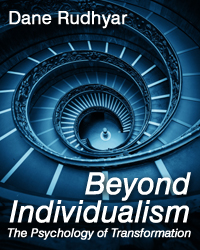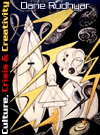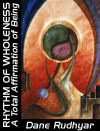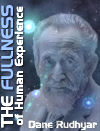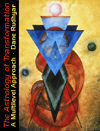Beyond Individualism
The Psychology of Transformation
by Dane Rudhyar
PART ONE:
THE PERSONAL-INDIVIDUAL MODE
2. The Four Orders of Functions
d. Functions of the Fourth Order
This seemingly Utopian picture most likely should not be taken as describing an even relatively imminent situation. If occult traditions are valid indicators of time periods—and there is always the possibility that they are of a more symbolic than actual or 'historical' character—the Promethean gift of the 'fire of individual selfhood' and reflective consciousness to mankind occurred millions of years ago. The seed-potentiality of developing an individualizing mind and a centralizing ego-function was released into the Earth's biosphere when the culture-developing functions of the second order were beginning to operate on a definite scale. Therefore, this 'seed' took a very long time to 'germinate'. It may also be that there was a first (and unsuccessful) germination under very adverse karmic 'weather', and that —in the fabled Atlantis—the first germ was frozen. A second attempt had to be made after some symbolic or actual 'Deluge'.
The functions of the third order have now reached a peak in their development; but once more mankind is experiencing a dangerous state of planet-wide, all-human infection produced by the inordinate glorification of—and dependence upon—intellectual fragmentation and ego-ambition. We have no way of knowing where it will lead, but we may well say that this potentially tragic condition was predictable. In a sense, it was inherent in the radically revolutionary approach to existence promoted by Guatama the Buddha, and by a few Greek philosopher-seers, especially Pythagoras. On the other hand, the Buddha (and probably Pythagoras) not only focused and released the transforming seminal power of an objective, rational and independently self-controlled mental activity, the very nature of this Buddha-focus also implied, and should have revealed, a mind-and-culture-transcending love for mankind—indeed, a Promethean kind of compassion.
This implied compassion had to be made explicit. The energy of an all-inclusive 'divine' love became focused in India, at least at a mental level, in the ideal of the Boddhisattva who renounces the spiritual freedom and supermental state of Nirvana until all sentient creatures (i.e., all living organisms in the Earth's biosphere) have reached such a condition of being and consciousness. A century after the Boddhisattva ideal began to spread through Northern India, this energy of supreme love became definitely embodied in the person of Jesus and was released to the world under the mystic name of Christ, through the potent symbol of the Crucifixion. This Christ gift can thus be compared to the Promethean gift; the latter referring to the release of the seed-potentiality of objective, metabiological mind-activity and of consciousness centered in individual self-hood, the former to the release of the seed-potentiality of an all-inclusive, universal, and divine love of which the Christian agape is a reflection.
Such a love is only the feeling aspect of the foundation upon which functions of the fourth order must develop, if their activity operates in a positive manner—i.e., along the direction of the evolutionary process leading to the state of seed-consummation, the omega state.(1) The foundation for the development of functions of the fourth order has also a mental aspect—mind as a field of holistic (rather than atomistic) activity, mind as a formative power operating according to the principle of inclusion, and no longer of exclusion.
The analytical mind creates categories in which many events, biological characteristics, or experimental data are classified according to their common external features; it is so intent on making its data fit into the categories that it automatically excludes—or at least considers totally unimportant and meaningless—whatever does not easily fit. On the other hand, the holistic (or spiritually synthesizing) mind works with basic principles of organization formulated in such a broad manner that they can include a vast number of data or activities which, while they may appear externally unrelated, nevertheless stem from a single root-reality or original creative impulse. Such an aspect of the human mind develops through the operation of what, many years ago, I called the cosmogenic function.
'Cosmos' means order, harmony and beauty. The cosmogenic mind is able not only to discover cosmos with and through chaos; it sees beauty in seeming ugliness. It can also act as a catalyst of order. Such a mind operates beyond the conflict between what lesser minds hypnotized by ethical-cultural differences consider 'good' and 'evil'; it sees both polarities as necessary for the continued release of power—just as no drawing can exist without a contrast between dark lines and light background. Behind agape-love and the holistic, cosmogenic mind stands the principle of interpenetration. At the level of a fourth order type of functional activity, all forms of existence begin to interpenetrate. At that level, ego-exclusivity, emotional possessiveness, and intellectual pride lose their power and glamor. They are seen to be only temporary means in the long and arduous process of differentiating human personalities, of stabilizing the relationship of center to circumference (and vice versa) and thus developing in depth an inner feeling of I-am-ness. They seem to be inevitable by-products of the emergence and full-growth of objective and reflective self-consciousness out of the matrices of biology and culture; but once their work is nearly finished, all these mental ego-building and ego-generated forms of mental activity should lose their opaqueness and mass. They should overcome their subservience to the concept of 'physicality' that served to integrate and stabilize sense-experiences and biopsychic feelings. Mind and ego should become translucent, allowing the light of the future and last state of human evolution—its omega condition—to pour through them. This pouring through of the omega radiance—which, for the Christian mystic, is identified with the cosmic Christ—must, in time, transfigure the biological into the spiritual. Enlightenment in its highest form means literally becoming light, which the radiance of saints and mystics prefigures.
Since the beginning of the 20th century, various movements have attempted to formulate—in terms of the present need of a humanity hypnotized by the intellectual and technological achievements of our Western civilization—concepts and ideals of emotional and mental transformation. In India, the great philosopher, poet, seer and yogi—Sri Aurobindo—saw himself faced with a twofold task. He questioned the significance and value of the several ways in which Hindu spirituality had developed for a very long time, and he sought to clarify and re-energize India's inner life, deeply shaken by the intrusion of Western thinking, by a vivid reinterpretation of the most ancient sources of Hinduism—the Vedas and the Upanishads. He went further and attempted to do what the Rishis of Vedic times could not do because of the purely biological level at which human tribes then operated, but had now become possible: that is, a direct, publicly formulated and personally dramatized focusing of the energy of the "Supermind"—the highest level of consciousness and spiritual realization open to mankind. What had presumably been available only to a few exceptional personages was, he felt, now a possible answer to a general, planet-wide human need, varied as the outer forms of the need might be. He sought to implant the germinal realization of the Supermind—which he and his partner in the Great Work, Mother Mira, had experienced—into the soil of the entire biosphere, even at the level of a transphysical manifestation.
In the Euro-American world, the formulation of concepts and ideals of emotional and mental transformation has begun to take place within the framework of science. On the one hand, modern atomic and subatomic physics since Einstein has been revealing a totally new and, so far, bewildering world far more 'transphysical' than physical.
In the field of psychology, after the spread of the catabolic and reductionist (even if emotionally releasing) Freudian psychoanalysis, came the 'Humanistic' movement. Humanistic psychologists have attempted to show that it is possible (and not even extraordinarily so) for human beings to experience states of consciousness beyond the limiting patterns built-up by the socio-cultural and intellectual functions of the third order and the ego. C. G. Jung began this process when he outlined a "healing way" out of neurosis and spiritual frustration by allowing the consciousness to open up to a vast realm of symbols and archetypes. Then Abraham Maslow, by concentrating on the study of the "peak experiences" of healthy and self-actualizing individuals, helped to reassess and redefine in psychological terms the components of a wholesome and harmonic kind of individualism. Recently, a further step toward developing the functions of the fourth order has been taken through 'Transpersonal psychology'. With Transpersonal psychology the attempt has been to carefully and as objectively as possible investigate, and then formulate the main characteristics of, ego-and-intellect-transcending states of consciousness which have been traditionally catalogued as 'mystical'.
It seems that the time has now come to present in as concrete and understandable a form as possible a new 'model' (the now current scientific term) of reality. This reality is gradually becoming more perceptible to the collective mind of a large number of thinking individuals because of the immensely expanded scope and transcendent implications of human activity. And I am not referring here only to a physical type of body-activity, but as well to consciously directed changes and processes operating at the level of the holistic mind—the mind of wholeness, the mind able not only to perceive events occurring in the sky, but to develop a 'cosmic' sense in relation to every human experience. I speak of a cosmic mind because it spontaneously and intuitively interprets any experience according to a holistic frame of reference according to which there is no essential difference between microcosm and macrocosm.
Whether one sees and defines them as small or vast, all organized fields of interdependent activities are existential wholes structured by principles which can best be called 'cosmic'. Though this often carelessly used and abused term may confuse some people, there seems to be no more appropriate qualificative to characterize mental processes (and some ritualized physical acts) which today must be clearly differentiated from the activities of biologically and culturally conditioned individuals (or groups), operating basically according to personal-emotional, ego-determined, and ethico-rational imperatives.
At the stage of mental development reached by humanity today, a profound, planet-wide need for the cosmification of human understanding and collective processes is making itself felt in a myriad of ways. Human life and human society should be repolarized and radically transformed by a cosmic meaning. But this meaning is not a 'given' one. It is not 'natural' in a biological, socio-cultural or strictly personal (ego-conditioned) sense. It has to be implanted or grafted to the ordinary consciousness of every human being by visionary individuals whose minds are becoming increasingly able to focus and release into a humanity in crisis the power and consciousness of what as yet is humanity's future state of evolution.
Mystics and metaphysicians may wish to speak of that future as 'here and now' in a timeless condition of 'being'; but such statements are the results either of ineffable but transitory experiences in moments of ecstasy, or of strictly intellectual and formalistic speculation largely dealing with negative concepts in an attempt to formulate the rationally unformulatable. Yet, the basic and incontrovertible fact of existence is change— which, as we experiences it, implies rhythmic motion and the incessant (or at least periodic) alteration of organized fields of activity and forms of consciousness. We cannot deny existence, because to deny it implies the existence of the denier—which negates the original denial of existence. A complete denial of existence is never possible because something (or somebody) existing has to make such a denial. We can only change the character and scope, the quality and intensity of our perceptions (inner or outer) and our interpretations.
For many centuries, human perceptions have been defined and interpreted by what we might call a physicogenic function. The operation of that function synthesizes the many data provided by our senses and some inner organismic feelings. As a result, our physical world is produced—a world of material bodies (whether atoms, cells, human beings or celestial bodies), a world of separate 'particles' attracting or repelling each other. A newly developing human function is now seeking to redefine and reinterpret man's immensely extended environment in a new transphysical, transpersonal, super-rationalistic and symbolic manner. This 'cosmogenic function' constitutes the central aspect of the holistic mind.
As already stated, this function characterizes the activity of a mind operating in multidimensional fields of existence according to the principle of total inclusiveness. As a result of this kind of operation, human consciousness perceives everywhere 'cosmoi'—interdependent and interpenetrating existential wholes. What constitutes a cosmos is not its size in space and time— whether it is an atom or a galaxy—but rather its essential character of total inclusiveness, even if a human consciousness seeking to embrace the actual totality of its manifestation falls very short of encompassing its entire field of activity. In that field and at any level of existence, all pairs of opposites, even that of actuality and potentiality (or being and non-being) should always be included.
What the modern Western mind defines as 'cosmology' is not, in the above-defined sense, truly 'cosmic', because it takes for granted that the universe it describes is exclusively physical. It therefore excludes the possibility of non-physical (whether sub- or super-physical) forms of existence as components of what it calls 'reality'. Moreover, implicitly if not explicitly, it still assumes that man, the observer, is in some undefined manner exterior to the astronomical processes he observes. Even if the modern cosmologist is religiously inclined, in most cases he also assumes, according to the tradition of his culture, that God created the universe by an act of will and imagination, and remains essentially outside of His creation. Such a fundamental 'outsideness' has no place in a truly cosmic vision of reality, according to the meaning I give here to this term, 'cosmic'. For a human consciousness fully operating at the level of functions of the fourth order, there can be no absolute outside—simply because every existential whole interpenetrates within the finite field of cosmic activity.
As every whole is part of a greater whole and contains parts which, as wholes, have parts, etc., there can ultimately be nothing outside. Each existential whole has its own space-field and time-span (cycle) insofar as it acts as a whole; but it also is subjected to the rhythms of the larger whole in which it operates as a part. That operation is structurally defined by these larger rhythms. Thus, while every living organism (human being included) has a biological rhythm of its own, determined by its total genetic ancestry, the overall development of its biological and psychic functions is also conditioned and constantly influenced by the pulsating and periodical rhythms of the planet Earth in the activity of which it participates—and also of the whole solar system (or heliocosm) whose power-center is the sun.
The phrase 'functions of the fourth order' refers to all the activities which, within the total field constituting a whole person—and not merely what we now interpret as a physical body limited to the skin or an ego-structured psyche—relate, on a consciously all-inclusive basis, the individual to the whole of which he (or she) accepts to act as a part.(2) The conscious development of such a relationship, and the discovery of all it implies, is what the 'cosmogenic function" is all about. In terms of its larger and potentially all-inclusive unfoldment, this function should produce, no longer a physicality-obsessed cosmology, but an all-inclusive multi-dimensional cosmosophy.
The mystic usually reaches the transcendent realization of a 'unitive state' of consciousness, beyond duality and the ordinary space-time framework of present-day human existence, by an intense chiaroscuro of feelings in which intensely dark, torturing periods precede (and at times also follow) moments of ecstatic illumination and bliss. He or she experiences to the utmost the great dramas of transcendent and absolute love, and lives in their most extreme forms the alternating emotions to which total union and seemingly irrevocable separation (or deep-seated guilt) give rise. In the unitive state, the mystic feels that all is included, all is one; yet the fundamental experience at the root of all experience—change—is denied. In timelessness all processes are invalidated, illusory. Only the greatest mystics reach beyond repudiating existence and realize that nirvana and samsara are but two aspects of an ineffable reality in which potentiality and actuality interact.
A 'cosmosophist' seeks to understand these interactions so as to move along the tide of evolution. He (or she) deals with the movement, instead of negating it in subjective experiences of timelessness and ecstasy. He deals with cyclicity rather than the separate phases of cycles. He deals with principles, rather than empirical phenomena which, he realizes, can only reveal their essential meaning and value when apprehended and understood in terms of their place and function within a whole process. Thus, for the cosmosophist, an individual seen under a 'cosmic' light appears as the representative of a particular phase of the cyclic process of human evolution. The individual's task (dharma or truth-of-being) is to bring to a focus in himself and through his activity what that particular phase is meant to accomplish in terms of the purpose of the entire process. As a person, he is a whole; but the wholeness of that whole takes its essential meaning from the position the person occupies within a larger whole in which he acts as a functional part.
What then is the larger whole of which an individual human being can consciously and significantly realize himself a functional part?
For countless millennia, no human being living in primitive tribal conditions could think of, much less feel and actually experience his participation in a 'greater whole' larger than his tribe. Later on, the field of an effective and realistic possibility of experienced participation extended to a province, then a kingdom, then a nation. Today, circumglobal travel, the astronauts' experiences of seeing Earth as a distant globe—shared by millions of TV viewers—and the publicizing of the interdependence of all forms of life within the biosphere have made it possible for people to be aware of the lives and sufferings of all human beings. Any well-informed, sensitive individual can now consider both humanity and the Earth as the greater whole in reference to which he (or she) can motivate and give meaning and value to his thinking, feeling and behavior. If he does so, the functions of the fourth order begin to operate. They operate now within the field of a consciousness that, having previously been individualized, is able to formulate itself with an objectivity and precision that were not possible before the functions of the third order had at least partially and effectively developed.
At the biological level, the sense of participation in a larger whole is unconscious and compulsive. At the socio-cultural level, it is collectivistic and subconsciously and emotionally binding; what is more, it is rooted in the principle of exclusion of the alien. At the level of the process of individualization, this sense of participation tends to disappear from the field of consciousness. Its reappearance, even in an attenuated and partial form, indicates that functions of the fourth order are becoming operative. All-inclusive, compassionate love and the activity of the cosmogenic mind are the two pillars upon which the entire development of these functions rests.
For a long time in the evolution of individual and even more of collective forms of consciousness, these pillars lack firmness and total reliability as supports of human activity. To love all human beings is very difficult in many situations. The Boddhisattva ideal of not only loving all human beings, but accepting an immensely long series of incarnations out of compassion for all living organisms, must seem even more unrealistic to all but an exceedingly few human beings, if they really understood and vividly experienced through feelings what this implies. Such an ideal must rest upon the total realization that the Earth is not only a living organism, but that humanity as a whole has a functional role to perform in it. Mankind performs that 'planetary' function through the operation of a long series of different kinds of societies and culture. Every 'culture-whole' represents a particular aspect of this function.
As I see it, this 'human function'—which we might call the archetype, Anthropos (Man)—consists of formulating, in mental and in concrete cultural terms, the meaning and value of every kind of activity operating within the entire planetary field of activity— a field which probably extends as far as the moon's orbit (what long ago was called the 'sublunar' realm—in a sense, the Earth's aura). Thus, mankind's function could be considered analogous to that of the several nervous systems in a human body. It implies far more than an accurate observation and meaningful interpretation of existential phenomena. Inherent in it is the possibility of not merely affecting, but, for better or for worse, radically transforming the operation of the various factors active within the entire planetary field.
We should now be well aware that humanity can pollute and might even destroy that field. Man can do it because, for so many centuries, he has been made to believe that essentially he did not belong to the Earth, a planet of conflicts and sorrows. He had been told (Genesis 1:28) that the whole world was made for him to deal with as he pleased—or that it was a school in which he had to learn arduous lessons. As long as the human mind holds this kind of thought or feeling-inducing imagery, and clings to it as a principle on which to base its conduct, it will be impossible for functions of the fourth order even to operate, let alone operate effectively.
Nevertheless, at one time this Biblical principle—which undoubtedly has equivalents in other cultures, but certainly not in all of them—had evident validity. It was needed to assist the process of individualization (functions of the third order). Human beings had to feel themselves essentially separate from nature in order that the whole energy of their collective (as well as individual) growth could be focused upon the development of the analytical, objective and rationalistic mind.
Today, however, humanity is faced by the dire results of such a collective attitude to which a religious sanction gave so much strength. The developing world-crisis can be successfully met —and first of all, understood—if at least the 'creative minority' (Arnold Toynbee's term) of humanity is able to overcome and transcend this basic concept of alienation and separateness from the Earth-as-a-whole; yet at the same time, we should retain the capacity to clearly formulate through some kind of evocative and potentially transformative language—i.e., through some new type of organization of symbols—the meaning we now see emerging from nuclear physics, galactic astronomy and international and intergroup relationships. The new language will evolve from the operation of the functions of the fourth order, and particularly from the cosmogenic function. But that function must no longer work in some kind of a human vacuum, as its first manifestations along purely abstract, scientific lines have done. It has to be open to the illumination which an all-pervasive Christic or Boddhisattvic love-compassion can bestow, or at the intellectual level, to what the potentially transforming concept of interpenetration can provide, if wholly and irrevocably accepted by our total being.1. Any function at any level of activity can operate in a negative way; thus, in opposition to the direction the evolutionary process takes at any point of a cycle. A cell or organ can become cancerous, developing uncontrolled against the holistic power of the organism-as-a-whole. A society and its culture can split and become fragmented into rival groups. An individual person can break down in psychosis as it becomes the battlefield on which individualizing trends war against socio-cultural inertia or the insistent demands of repressed biopsychic functions. So also the Christian agape, haunted by an emotionalized ideal of 'salvation', can degenerate into the fanaticism manifesting as the Medieval Inquisition, torturing bodies to save souls. More details concerning the dualism of evolutionary and anti-evolutionary forces will be found in The Planetarization of Consciousness, Part 2. Return
2. My book, The Planetarization of Consciousness in which my whole philosophy of existence is contained in seed, has the subtitle From the Individual to the Whole; but few readers seem to have paid attention to this subtitle. Return
3. Seed Functions and Rites of Passage<
Copyright © 1979 by Dane Rudhyar.
All Rights Reserved.
See Notices for full copyright statement and conditions of use.
Web design copyright © 2000-2004 by Michael R. Meyer.
All Rights Reserved.


